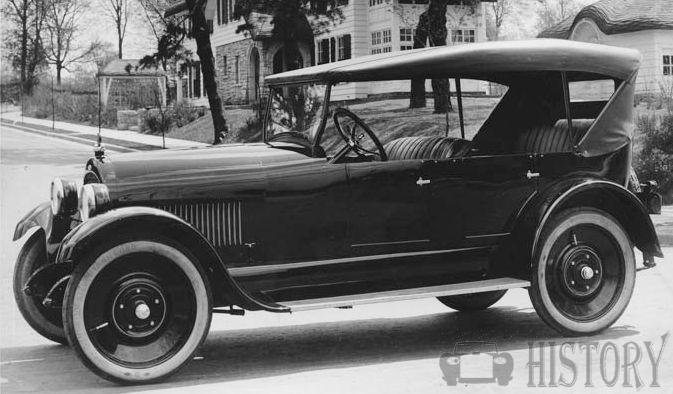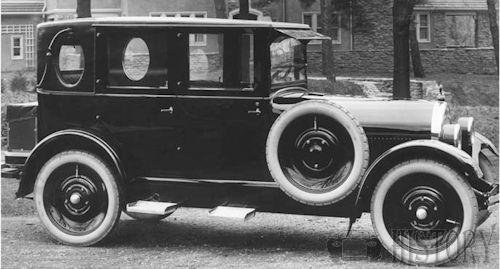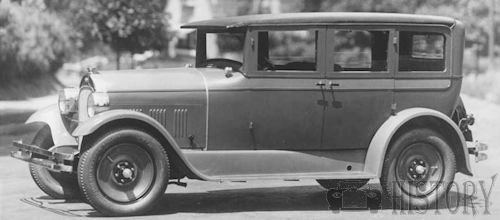George W. Davis Motor Car Company
George W. Davis Motor Car Company , formerly George W. Davis Carriage Company , was an Americanmanufacturer of automobiles .The brand name was Davis .
History
George W. Davis founded in 1902 the George W. Davis Carriage Company for coach manufacturing in Richmond , Indiana . In 1908, the company was renamed George W. Davis Motor Car Company , as the production of automobiles began. Walter Davis is named second person at this time. In the best years created over 1000 vehicles. .In February 1928, the Automobile Corporation of America headed by Villor P. Williams took over the company. The production continued in small numbers and ended in 1928. Existing vehicles were sold until 1929. Lawn mowers were made in 1930.
From 1908 to 1910 Highwheeler were produced.In 1911, more modern and more deeply built vehicles came on the market. They had a four-cylinder engine from Continental Motors Company . In the Thirty-Five he made 35 hp and the Fifty 50 hp. The weaker model had 284 cm wheelbase and the stronger model 305 cm wheelbase. Both were available as a Fore-Door Touring Carand a five-seat Torpedo .
In 1912, there was only the Series 40 . The engine made 40 hp. The chassis had 284 cm wheelbase. The vehicles were a five-seat touring car, four -seater torpedo touring car and two-seater roadster body.
In 1913, the wheelbase was extended to 300 cm in the Series 40 . The torpedo was dropped. The Series 50 supplemented the range. The engine made 50 hp. The wheelbase of the five-seat touring car corresponded to the weaker model.
1914 were three models on offer. In model 35-K the engine made 20 hp. The two-seat Roadster had 284 cm wheelbase. The Model 50-A had a 32 hp engine, 300 cm wheelbase and a five-seat touring car body. The Six-50 was the first model of the brand with a six-cylinder engine . He made 50 hp. The wheelbase was 328 cm. The open touring car offered space for five people.
In 1915, the Model 38 replaced the smallest model of the previous year. The engine power was increased slightly to 23 hp, while the wheelbase remained the same. The two-seater roadster was joined by a five-seat touring car. The middle model was eliminated. The Six-50 had a slightly shorter wheelbase at 325 than in the previous year. The engine remained unchanged. The touring cars had either five or six seats.

Davis 1916 roadster
1916 was the last year for a four-cylinder model. The Model C-38 was the same as the previous Model 38 . In Model 6-E , the engine made 50 hp. On a wheelbase of 315 cm, a seven -seat touring car body was mounted. Model 6-F as a four-seat roadster and model 6-G as a five-seat touring car had identical 30 hp and 305 cm wheelbase.
In 1917 there were two different models with the same name Model 6-H . One version had a 30-hp engine, 302 cm wheelbase and superstructures as a seven-seat touring car, five-seat Club Roadster and seven-seater sedan . The more powerful version with 50 hp engine and 315 cm wheelbase was only available as a touring car with seven seats.Many Davises were exported, and a Davis placed first in a hill climb in Madrid, Spain in 1917. Also in 1917, the growing Davis company expanded by taking over the former Westcott factory in town. The Davis was an assembled car, meaning that it used components from various outside manufacturers, with little or none of the components made in-house. Davises were well known for their two-tone paint schemes and poetic model names, such as Fleetaway, Man o' War and Mountaineer.
1918 came to model 6-H with 302 cm wheelbase, the model 6-K with 318 cm wheelbase. The engine was indicated in each case with 30 HP. The bodies as four- and siebensitzige touring car, five-seat Club Roadster and seven-seater sedan did not differ.
The Davis served as the basis for two badge-engineered cars sold in Canada in the 1920s - the Winnipeg and the Derby.

Davis 1922 Touring car
1919 saw the restriction to the smaller model, but with 305 cm wheelbase. There was a choice of touring cars and sedans, each with seven seats, a touring car and four-seater coupé, as well as a Chummy Roadster .
In 1920 it became the Series 50 . The engine power was increased to 38 hp. Five-seater touring cars, four-seater sports , four-seater Special Sport , five-seater sedan and four-seater coupe have been handed down.
1921, the engine was specified with 58 hp. The vehicles were available as touring car and sedan with five seats, Sport and Special Sport with four seats, Roadster and Special Roadster with three seats and coupe with four seats.
For 1922 it is only known that Series 60 and Series 71 were on offer.
The fortunes of the Davis company waned later in the 1920s. Later Davises were obsolete, and sales began to slip from the peak sales of the early 1920s. In February 1928, the company was acquired by the Automotive Corporation of America, led by Villor P. Williams.Williams was interested in gaining an automobile on which to install his Parkmobile device. The Parkmobile was a device which hydraulically raised the car up via a set of smaller wheels inboard of the standard ones. This allowed the vehicle to be rolled sideways into a parallel parking space. It operated "through the regular gearshift lever in conjunction with an extra lever operated from the transmission." The six-cylinder Davis was now renamed the New York Six, while the 8-cylinder model remained a Davis. Both of these were to get the Parkmobile device, only a few did, however. Any 1929 models were simply ones built using leftover 1928 parts.

1924 Davis Brougham
1923 saw an extension of the assortment. In the Series 60 , the engine made 64 hp. The wheelbase was 305 cm. The superstructures were called Man O'War with three seats and Fleetaway with either four or five seats. The Series 70 had a 52 hp engine and a chassis with 292 cm wheelbase. She gave it as a three-seater roadster, four-seat sports and coupe, five-seat Phaeton , sedan and California as well as a seven-seat touring car. A 68 hp engine powered the Series 80 with 300 cm wheelbase. The Roadster had three seats, the touring car four seats and the sedan five seats. This came inUtility Brougham .
In 1924, only the middle series was manufactured. Five-seated Phaeton, Legionare with four seats, Man O'War with three seats, Utility Bourgham with five seats, Brougham with four seats and two different limousines each with five seats have been handed down.
In 1925 it became the Model 90 , but with a wheelbase extended to 300 cm. The normal brougham was eliminated, while the Man O'War was now four-seated. Added to this was the Model 91 with a 68-hp engine and 295 cm wheelbase. As superstructures Roadster with four seats as well as Phaeton, Brougham and limousines with five seats are called.
In 1926, the latter model was renamed Model 92 . The Man O'War offered four seats, while Touringcars , Legionaires, and three different limousines were five-seater. The Model 93 supplemented the assortment. The engine made 48 hp. The wheelbase was 277 cm. The vehicles were bodied as a sedan with five seats.
In 1927, the only change to the Model 92 was replacing the Man O'War with a four-seat roadster. The bodyshell for the Model 93 has been extended by a three-seater coupe. New on the market appeared the Model 98 . The eight-cylinder engine made 85 hp. The chassis had 302 cm wheelbase. The superstructures were named Polo Roadster and Princess Coupé , each with four seats, as well as Emperior Sedan and Legionaire Touring , each with five seats.
In the last year of production in 1928, the offer consisted only of the Model 99 . He corresponded with respect to engine, wheelbase and bodies the eight-cylinder model of the previous year.
Williams was evicted on May 30, 1929 for not paying rent, and returned to Baltimore, Maryland, where his Automotive Corporation was headquartered. The Richmond factory was turned over to the manufacture of power lawn mowers. Williams continued to advertise into early 1931 that more New York Six and Davis Eight automobiles with the Parkmobile device were to be forthcoming, but none ever materialized.
Later 1927 Davis sedan

Technical
-
Davis Model overview (1908-1929)
year
model
cylinder
Power (PS )
Wheelbase(cm)
construction
1908-1910
Motor buggy
1911
Thirty-Five
4
35
284
Fore-Door Touring Car, torpedo 5-seater
1911
Fifty
4
50
305
Fore-Door Touring Car, torpedo 5-seater
1912
Series 40
4
40
284
Touring car 5-seater, Torpedo touring car 4-seater, Roadster 2-seater
1913
Series 40
4
40
300
Touring car 5-seater, roadster 2-seater
1913
Series 50
4
50
300
Touring car 5-seater
1914
Model 35-K
4
20
284
Roadster 2-seater
1914
Model 50-A
4
32
300
Touring car 5-seater
1914
Six-50
6
50
328
Touring car 5-seater
1915
Model 38
4
23
284
Touring car 5-seater, roadster 2-seater
1915
Six-50
6
50
325
Touring car 5-seater and 6-seater
1916
Model C-38
4
23
284
Touring car 5-seater, roadster 2-seater
1916
Model 6-E
6
50
315
Touring car 7-seater
1916
Model 6-F
6
30
305
Roadster 4-seater
1916
Model 6-G
6
30
305
Touring car 5-seater
1917
Model 6-H
6
30
302
Touring car 7-seater, Club Roadster 5-seater, Sedan 7-seater
1917
Model 6-H
6
50
315
Touring car 7-seater
1918
Model 6-H
6
30
302
Touring car 4-seater and 7-seater, Club Roadster 5-seater, sedan 7-seater
1918
Model 6-K
6
30
318
Touring car 4-seater and 7-seater, Club Roadster 5-seater, sedan 7-seater
1919
Model 6-H
6
30
305
Touring car 4-seater and 7-seater, Chummy Roadster, Sedan 7-seater, Coupe 4-seater
1920
Series 50
6
38
305
5-seater touring car, 4-seater sports, 4-seater special sports, 5-seater saloon, 4-seater coupe
1921
Series 50
6
58
305
5-seater touring car, 4-seater sports, 3-seater roadster, 3-seater special roadster, 4-seater coupe, 5-seater saloon, 4-seater special sports
1922
Series 60
6
1922
Series 71
6
1923
Series 60
6
64
305
Man O'War 3-seater, Fleetaway 4-seater and 5-seater
1923
Series 70
6
52
292
5-seater touring car, Phaeton 5-seater, 4-seater sports, 3-seater roadster, 5-seat sedan, 4-seater coupé, 5-seater California
1923
Series 80
6
68
300
Saloon 5-seater, 4-seater touring car, 3-seater roadster, Utility Brougham
1924
Series 70
6
52
292
Phaeton 5-seater, Legionaire 4-seater, Man O'War 3-seater, Utility Brougham 4-seater, Saloon 5-seater
1925
Model 90
6
52
300
Phaeton 5-seater, Man O'War 4-seater, Legionaire 4-seater, Utility Brougham 5-seater, Sedan 5-seater
1925
Model 91
6
68
295
Phaeton 5-seater, Roadster 4-seater, Brougham 5-seater, Sedan 5-seater
1926
Model 92
6
68
300
5-seater touring car, Man O'War 4-seater, 5-seater sedan, 5-seater legionaire
1926
Model 93
6
48
277
Sedan 5-seater
1927
Model 92
6
68
300
Touring car 5-seater, Roadster 4-seater, Sedan 5-seater, Legionaire 5-seater
1927
Model 93
6
48
277
Saloon 5-seater, Coupe 3-seater
1927
Model 98
8th
85
302
4-seater Polo Roadster, 4-seater Princess Coupé, 5-seater Emperor sedan, 5-seater Legionaire touring car
1928
Model 99
8th
85
302
4-seater Polo Roadster, 4-seater Princess Coupé, 5-seater Emperor sedan, 5-seater Legionaire touring car
Davis Production figures
year
production number
1910
136
1911
320
1912
699
1913
732
1914
820
1915
623
1916
823
1917
940
1918
872
1919
923
1920
1780
1921
1363
1922
1213
1923
949
1924
812
1925
692
1926
98
1927
98
1928
26
total
13919



